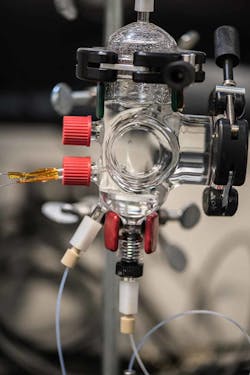NREL Sets a New Record for Efficiency in PEC Device
Earlier this year, the NREL submitted research to Nature Energy showing record-breaking solar-to-hydrogen conversion efficiency in a photoelectrochemical (PEC) fuel cell. Through revision of past methods, the team could confidently report an efficiency of 16.2% using updated standards of measurement.
The PEC device uses a tandem photovoltaic cell with two types of semiconductors stacked on top of one another—a design that enables absorption across a wider spectrum of sunlight. Team member and senior scientist at NREL, John Turner, was also part of the team the set the record for PEC device efficiency in 1998.
But it was not until recently that Turner and his team recognized factors in their research that skewed their measurements. For instance, an epoxy used to seal the edges of the PV cell changed the area of light transmission, but was not accounted for in the performance measurements. This and similar overlooks set their record conversion efficiency in 1998 of 12.4% to just 9.3%.
The team then began to investigate other studies to analyze methods used for measuring PEC device efficiency. In doing so, they recognized similar oversights that led to inflated efficiency measurements. In a report Solar-to-hydrogen Efficiency: Shining Light on PEC Device Performance published in 2015, the team outlines common oversights in efficiency testing, and proposes new standards for measuring and reporting PEC performance.
"We discovered some of our previously used methods, and those used by others in the field, led to measurement errors," says NREL senior scientist Todd Deutsch. "We realized that several labs, including ours, had reported inflated values for efficiency. Before moving forward with more accurate measurements, we needed to address these errors and disseminate a standardized measurement approach to the community."
In this particular PEC device, current from a PV cell is transferred through an electrolyte to the anode, supplying the activation energy necessary for oxidation of a hydrogen fuel. Oxidation produces both positive hydrogen ions and electrons that can be used for a variety of applications. In a fuel cell, hydrogen can be transferred through an electrolyte to combine with oxygen gas supplied at the cathode, while electrons can create a current that powers a load. Water is generated as a byproduct of the fuel cell.
Despite record efficiencies in the prototype, there are other factors that need to be addressed before the design is applicable for widespread hydrogen production and energy generation. For instance, one way the design boosts performance is by submerging the tandem PV cell in an acidic electrolyte. Despite reducing transmission losses compared to current transfer through a wire from the PV cell to the anode, the acidic liquid corrodes the PV cell, severely limiting its useful life.
"Acid essentially eats away your semiconductor and they're really expensive, so you need it to last several years instead of several hours," says Deutsch.
To address this problem, the team applies a thin layer of aluminum indium phosphide (AlInP) and a second thin layer of GaInP2 on top of the semiconductor to reduce corrosion in the electrolyte. Still, further investigation of materials is needed to reduce this effect.
The team would also need to come up with scalable technology to manufacture their PV cell. The cell—known as an inverted metamorphic multi-junction device because it is grown upside down—replaces GaAs used in the 1998 design with indium gallium arsenide (InGaAs), which is grown on top of gallium indium phosphide (GaInP2).
About the Author
Leah Scully
Associate Content Producer
Leah Scully is a graduate of The College of New Jersey. She has a BS degree in Biomedical Engineering with a mechanical specialization. Leah is responsible for Machine Design’s news items that cover industry trends, research, and applied science and engineering, along with product galleries. Visit her on Facebook, or view her profile on LinkedIn.

